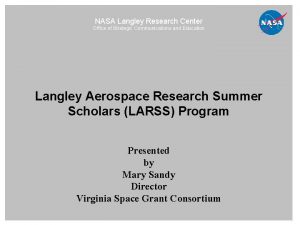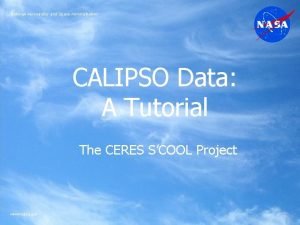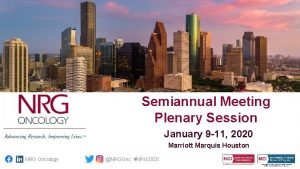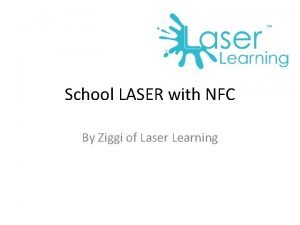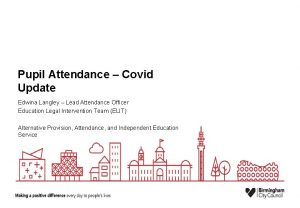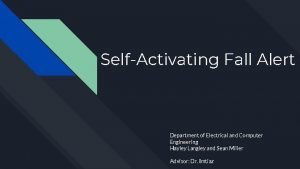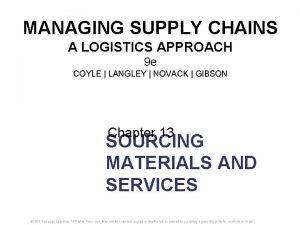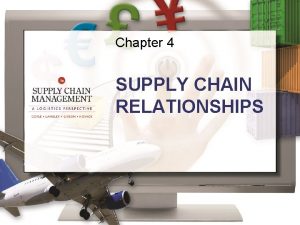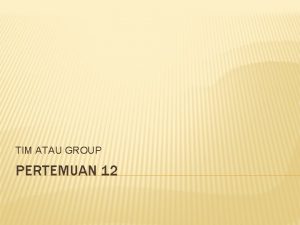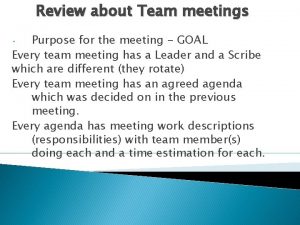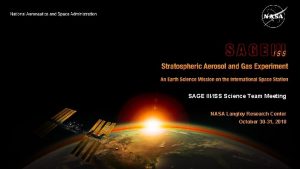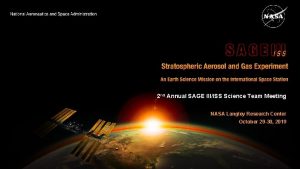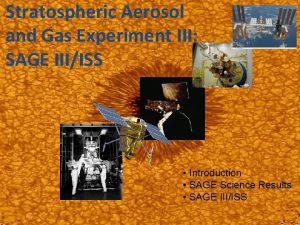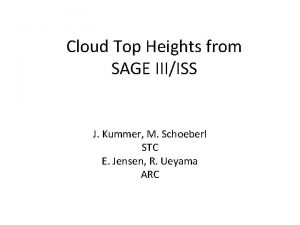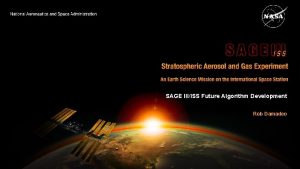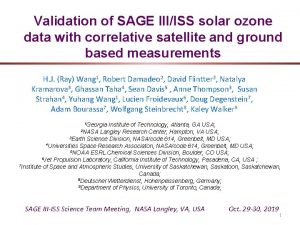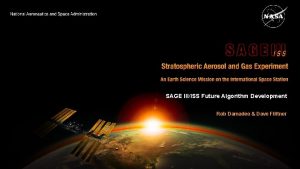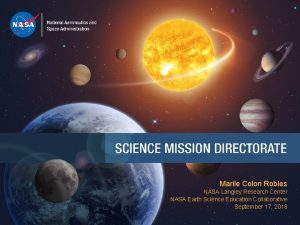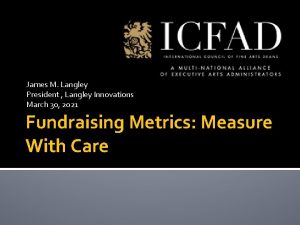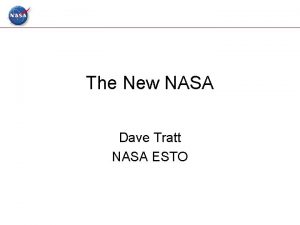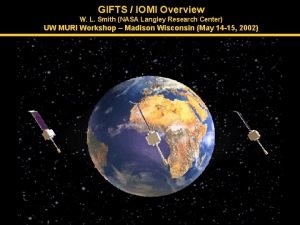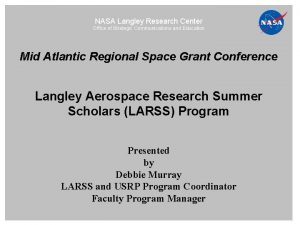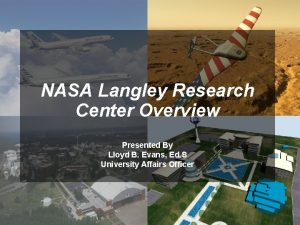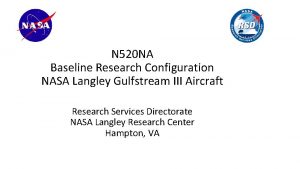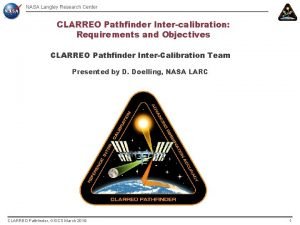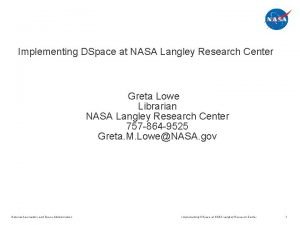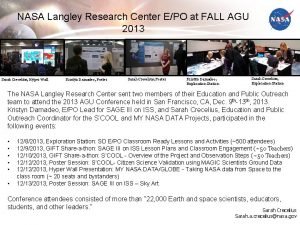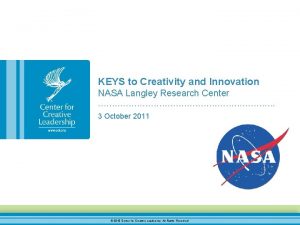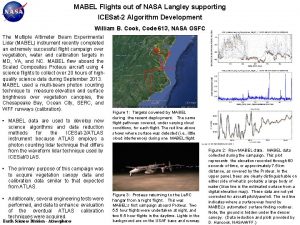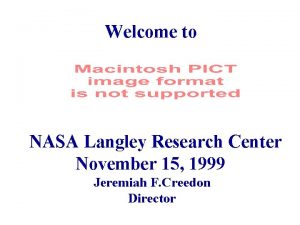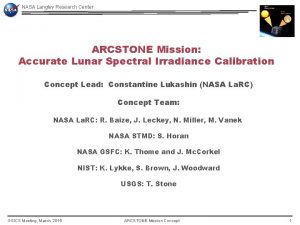2018 SAGE IIIISS Science Team Meeting NASA Langley
























![Research Data Products PRODUCT Event Type Vertical Range & Resolution [km] Precision [%] Accuracy Research Data Products PRODUCT Event Type Vertical Range & Resolution [km] Precision [%] Accuracy](https://slidetodoc.com/presentation_image_h2/20857175c70b55d808865c3241af15b4/image-25.jpg)



- Slides: 28

2018 SAGE III/ISS Science Team Meeting NASA Langley Research Center October 30 -31, 2018

Welcome! October 30 -31, 2018 2

LOGISTICS Ø Internet access • Wireless connection for visitors: log into “nasaguest” and open a clean browser window • Wireless connection for NASA-badged employees: log into “nasa” Ø Call-in: 1 -844 -467 -6272, #896850 Ø Lunch • Lunch will be on your own; the La. RC Cafeteria is at the north end of the building Ø Meeting location: • Restrooms – out the door, left, then left • Coffee, etc. in the back of the room • Flight Mission Support Center (FMSC) on second floor October 30 -31, 2018 3

Directions to Meeting (Building 2102) 2102 October 30 -31, 2018 4

Building 2102 EATING SPACE CAFETERIA REID 3 October 30 -31, 2018 5

Objectives Ø Communicate to the ROSES Science Team the status of: • • Mission Operations Data processing Validation Ø Initiate and foster collaborations amongst the Science Team and the Mission Team Ø Do good science… October 30 -31, 2018 6

AGENDA October 30 -31, 2018 7

Mission Overview D. Flittner & M. Roell

Outline Ø Background Ø Overview of mission Ø Current status of mission Ø Road ahead October 30 -31, 2018 9

Objective of SAGE Ø Monitor the vertical distribution of aerosol, ozone and other trace gases in the Earth’s stratosphere and upper troposphere Ø SAGE III/ISS will provide data necessary to: • Assess the state of the recovery in the distribution of ozone • Extend the stratospheric aerosol measurement record needed by Climate and Ozone models • Gain further insight into key processes contributing to ozone and aerosol variability October 30 -31, 2018 Steinbrecht, et al. 2017 10

Background Ø Proposal submitted and selected in 1988 as EOS mission • Three instruments: mid-inclined orbit (SAGE II – like) for most of the globe; highinclined orbit for polar regions; instrument of opportunity (FOO). Ø Instruments built by Ball Aerospace • All units delivered in late 1990 s, early 2000 Ø NASA HQ played match maker for two of the three instruments • High-inclined: Hosted payload on Russian Meteor 3 M meteorlogical satellite: Dec. 2001 – Apr. 2006 • Mid-inclined: Hosted payload on International Space Station (ISS) § ISS arranged additional hardware to place SAGE in the correct orientation – Hexapod provided by European Space Agency via Alenia Ø ISS mission postponed 2005 • Hardware & Software delivered to close-out Ball contract October 30 -31, 2018 11

Background cont. Ø Science community support for SAGE measurements prompts NASA to restart SAGE III/ISS in 2010 as climate continuity mission Ø Strict marching orders to reuse hardware and software • SAGE taken out of storage showed same performance as day it was stored • Hexapod removed from storage and refurbished by ESA Ø Baseline mission period of 3 years Ø ISS external payload opportunities evolved since 2005 • Need to bring own 90° bracket; secured a choice seat up front Ø Payload augmented to characterize the relatively unknown ISS external environment for optical Earth remote sensing instruments • Contamination Monitoring Package • Disturbance Monitoring Package October 30 -31, 2018 12

SAGE III – Mission Architecture October 30 -31, 2018 13

SAGE III/ISS Integrated Payload (IP) Ø Collaborative effort: NASA (SMD, HEOMD-ISS) & ESA Sensor Assembly (SA) Hexapod Mechanical Assembly (HMA) Contamination Monitoring Package (CMP) Disturbance Monitoring Package (DMP) October 30 -31, 2018 Instrument Control Electronics (ICE) Hexapod Electronics Unit (HEU) Contamination Monitoring Package (CMP) Interface Adapter Module (IAM) Ex. PRESS Payload Adapter (Ex. PA) 14

Launch/Installation/Activation Ø Launched Feb. 19, 2017 in unpressurized payload area of CRS-10 Ø Completed robotic installation process March 9, 2017 Ø First light March 16, 2017 2 nd Stage Separation of Space. X Dragon CRS-10 October 30 -31, 2018 SAGE installed on ISS 15

SAGE III’s location October 30 -31, 2018 16

Typical Orbit Limb Scatter October 30 -31, 2018 Sunrise Sunset Moonset 17

Instrument Assembly Ø Instrument summary (solar occultation mode): • 0. 5 arc-min (0. 5 km) IFOV scans the vertical extent of solar disk • Spectrometer: 290 nm to 1020 nm with 1. 4 to 2. 0 nm resolution • Focal plane also includes 1540 nm diode channel Ø Successfully replaced solar attenuator to eliminate ‘etalon’ Ø Refurbishment examined all mechanisms Ø Important software upgrades Ø Extensive ground testing • Optical characterization • Complete environmental October 30 -31, 2018 18

Commissioning Ø The core SAGE measurements, Solar occultation, were demonstrated at first light on March 16, 2017 Ø Basic functionality and sensitivity to control table parameters were exercised and refined, and important characterizations performed December 20, 2021 19

Etaloning seen during M 3 M Ø Soon after operation of the SAGE III/M 3 M instrument began, anomalous behavior in the high altitude transmission profile was discovered Ø A low frequency “wave” with amplitude as large as 0. 3% was seen in some channels Ø Wave period varied with wavelength in a manner consistent with a etalon Ø Inability to fully characterize compromised science Ø Further analysis concluded that the etalon must be thick, on the order of several millimeters Ø Candidate sources were assessed and the solar attenuator was identified as the most likely source October 30 -31, 2018 20

Etaloning Evaluation Ø The original attenuator for ISS was tested and found to be plane parallel Ø A replacement attenuator was fabricated with a wedged substrate and tested Ø The new attenuator and associated mechanism was installed in the flight instrument Ø On orbit performance demonstrates effectiveness of the replacement October 30 -31, 2018 21

SAGE III/ISS Spatial/Temporal Sampling No significant sampling issues arise from ISS blockages December 20, 2021 22

Spectral Sampling Limb Lunar October 30 -31, 2018 SAGE III Solar: Aerosol Mes. O 3 NO 2 O 3 O 2(T, p) H 2 O 23

Standard Data Products: Provisional version, V 5. 1 PRODUCT Event Type Vertical Range & Resolution [km] Precision [%] Accuracy Goal [%] Spectral Transmission Solar 0* – 100, 0. 75 0. 1*** Aerosol Extinction & Optical Depth Solar 0* – 40, 0. 75 5 5 Ozone# Solar 0* – 50, 0. 75 5 5 Water Vapor# Solar 5* – 45, 0. 75 10 10 Nitrogen Dioxide# Solar TP+2 – 45, 0. 75 10 10 Ozone# Lunar 15* - 45, 1. 5 5 6 Nitrogen Trioxide# Lunar 25 – 45, 1. 5 15 10 Nitrogen Dioxide# Lunar 20 – 45, 1. 5 10 10 October 30 -31, 2018 # concentration; * Or cloud-top/ISS; ** at 600 nm Beta Delayed 24
![Research Data Products PRODUCT Event Type Vertical Range Resolution km Precision Accuracy Research Data Products PRODUCT Event Type Vertical Range & Resolution [km] Precision [%] Accuracy](https://slidetodoc.com/presentation_image_h2/20857175c70b55d808865c3241af15b4/image-25.jpg)
Research Data Products PRODUCT Event Type Vertical Range & Resolution [km] Precision [%] Accuracy Goal [%] Temperature Solar 0* – 85, 0. 75 2 K 2 K Pressure Solar 0* – 85, 0. 75 2 2 Ozone (Mesospheric)# Solar 60 – 90, 1. 0 5 10 Chlorine Dioxide# Lunar 15* – 25, 1. 5 20 25 Limb Radiance (L 1 B) Limb 0 – 60, 0. 75 2. 5 10 See Poster # concentration; * Or cloud-top October 30 -31, 2018 25

Prime Mission Team • • • Josh Bangert Bob Borchardt Andrea Cowley Rob Damadeo Tyler Dawson Jim Farmer Mike Heitz Jon Hicks Charles Hill Dave Huber Carter Hulsey Susan Kizer October 30 -31, 2018 • • • Travis Knepp Marsha Larosee Kevin Leavor Allison Leybold Kaitlin Liles Danny Mangosing Robbie Manion Josh Mc. Donald Randy Moore Sudha Natarajan Jamie Nehrir • • • Greg Paxton Andrew Peterson Mike Pitts Sam Porter Marilee Roell Carrie Roller Amy Rowell Caitlyn Stone Larry Thomason Michael Thompson 26

Extended Mission Review Schedule Ø March 2020: Senior Review Cycle FY 21 – FY 23 • • Senior Review for Earth Science Projects Held every three years Mission Extension Review Will provide extension funding to bridge to EPMR Ø July/August 2020: End of Prime Mission Review • 3 year Phase E Prime Mission ends June 30, 2020 • Review cycle has this occurring 30 – 60 days after Senior Review • Present that we met our Level 1 requirements to closeout the primary mission October 30 -31, 2018 27

Summary Ø SAGE III/ISS is a climate continuity mission addressing critical international science needs: sage. nasa. gov Ø SAGE III/ISS is operating nominally with additional data released at monthly intervals: eosweb. larc. nasa. gov/project/sageiii-iss_table Ø Experience on ISS has grown rapidly, consistently collect 90% of solar opportunities, 85% solar+lunar. Ø Provisional Ozone/Aerosol Data w/ V 5. 1 Ø Preliminary comparisons of mid-stratosphere ozone within ± 10% of validated sources Ø Beta version of water vapor product w/ V 5. 1 Ø DMP has potential to mitigate impact of mechanical disturbances on data products Ø Baseline mission is July 2017 – June 2020; continuation renewed in 3 -yr cycles October 30 -31, 2018 28
 Al langley nasa
Al langley nasa Nasa langley org chart
Nasa langley org chart Ito namang pinsan ko saka lang kikilos pag
Ito namang pinsan ko saka lang kikilos pag Nasa www.nasa.gov
Nasa www.nasa.gov B a f c j e
B a f c j e Describe your favourite subject english
Describe your favourite subject english Aua meeting 2018
Aua meeting 2018 Nrg oncology meeting
Nrg oncology meeting Nrg oncology conference
Nrg oncology conference Langley hall primary academy laser login
Langley hall primary academy laser login Cardinal langley school holidays
Cardinal langley school holidays Cardinal langley rc high school
Cardinal langley rc high school Walter langley
Walter langley Edwina langley birmingham
Edwina langley birmingham Edwina langley birmingham
Edwina langley birmingham Edwina langley birmingham
Edwina langley birmingham Hayley langley
Hayley langley Kraljic supply matrix
Kraljic supply matrix C. john langley, jr., ph.d.
C. john langley, jr., ph.d. Short term rentals langley
Short term rentals langley For todays meeting
For todays meeting Proposal kickoff meeting agenda
Proposal kickoff meeting agenda What is meeting and types of meeting
What is meeting and types of meeting What is meeting and types of meeting
What is meeting and types of meeting Cft meetings
Cft meetings Team building meeting definition
Team building meeting definition Team around family
Team around family Team meeting objectives
Team meeting objectives Team review meeting
Team review meeting
